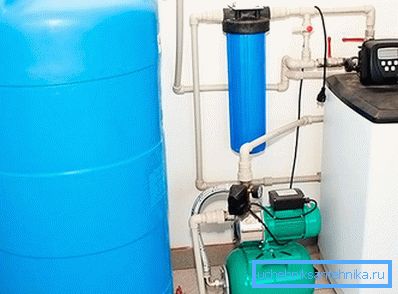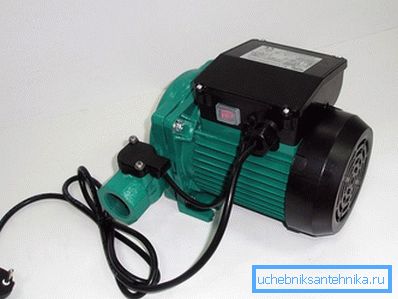Pumps to increase water pressure
Having a water supply in a house or apartment is not only a great boon, but also ensuring compliance with hygiene standards. True, in the existing realities, this benefit is not always of the necessary quality. In high-rise buildings and private houses connected to the central water supply, the water pressure may be less than 1.5 atm or more than 5 atm (it should be borne in mind that for many devices, especially imported ones, a pressure of 6–7 atm is destructive). To ensure the normal operation of all household plumbing appliances and the ability to simultaneously use multiple water intakes (mixer + shower + washing machine), it is necessary that the system has a pressure of 3-4 atm. According to the existing standards, the pressure in the central water supply system should be 4–4.5 atm. If these figures are lower, then to enforce a normal head, pumps are used to increase the water pressure.
Species

Classification of units for increasing water pressure:
- Pumps with two modes of operation: manual and automatic. When the pump is switched to manual mode, it runs continuously. At the same time, its overheating and breakdown are not excluded. In automatic mode, the pump is turned on only when the household begins to use water and at the same time pressure is required to increase. If the pressure in the system is equal to the parameters for which the pump is configured, it will not turn on. For automatic operation, a flow sensor must be included with the pump. This mode is the most economical, prolongs the life of the unit and protects it from working "dry" (without water), which leads to device breakage.
- Pumping stations, which include a centrifugal pump, a water supply tank and automatic controls. Such units maintain pressure not directly, but by, first of all, the flow of water from the reserve tank. When the pressure in it drops, then the water is drained from the water supply to replenish the tank.
The differences of pumps according to the method of cooling the body:
- With a dry rotor, these are pumps in which the blades of the impeller mounted on the shaft produce cooling. The advantage is a high percentage of efficiency, and the disadvantage is the noise during operation.
- With a wet rotor - the case is cooled by the liquid that it pumps. The unit works almost without noise - an important advantage for a small room.
There are pumps that are designed for installation on cold water or only on hot water, there are also universal models.
Where are the devices installed

Naturally, step-up pumps are installed when there is a lack of pressure in the water supply system, or it is necessary to ensure normal water pressure in a private house when it is taken from a well (well).
Before buying and installing a pump, make sure that it is necessary. Sometimes a poor water supply can be due to clogged water pipes and the installation of pumping equipment will not help.

For installation in the apartment using compact pumps with two modes of operation: manual and automatic. It is better to use silent models. Small pumps are chosen because, as a rule, the installation space is limited. The performance of the unit and its technical characteristics are selected after the calculations, which you can do for free in the company stores selling pumping equipment. If the apartment has a large area and there is a place in it to install a pumping station, then if necessary it is better to install it. The pump is ideal for the apartment, because it does not take into account the loss of water pressure on the way from the source to the consumer. These losses are compensated by the central water supply.

In a private house connected to the central water supply, they also install just a pump, not a pumping station. This usually helps. If the source of water is a well or a well, then it is better to install a pumping station with a large tank of water.
When calculating the working capacity of the unit, it is necessary to take into account the need to raise water from a certain depth. It is better to choose models that can provide a minimum pressure of 1.5 atm and protect against overpressure above 5 atm.
Installation

Pressure pumps and pumping stations should be installed on the water inlet after the water meter. Consider two installation schemes: a pump in the apartment and a pumping station in a private house.
If the pump is installed in the apartment, the installation scheme is as follows:
- Shut off the water supply to the apartment and drain the residues from the internal water supply system (open the mixer).
- Cut the pipe after the water meter and cut a pipe section equal to the length of the pump on top + fastener size + check valve size.
- At the end of the pipe, which is closer to the water meter, screw the check valve. A non-return valve prevents water from flowing out of the pump at the time of stopping the water supply.
- Secure the flare fittings to both ends of the pipe. Fittings for connection depend on the pipe material.
- Mount the pump on the nuts and attach the flow sensor to it.
- Install the power cord with a power outlet.
It is important not to confuse the direction of water movement, it is indicated by the arrow on the body. When everything is ready, turn on the water and start the pump.

In a private house to maintain the required water pressure is better to install a pumping station. The scheme of its installation does not differ from the scheme of installation of the pump. Only it is necessary to take into account that when installing a pumping station at a well in the well on the street, it must be insulated so that the water inside the unit does not freeze. You can install the station in the back room of the house, if it passes through the input into the house.
Video
From this video you will learn how to increase the pressure of water in a house or apartment: